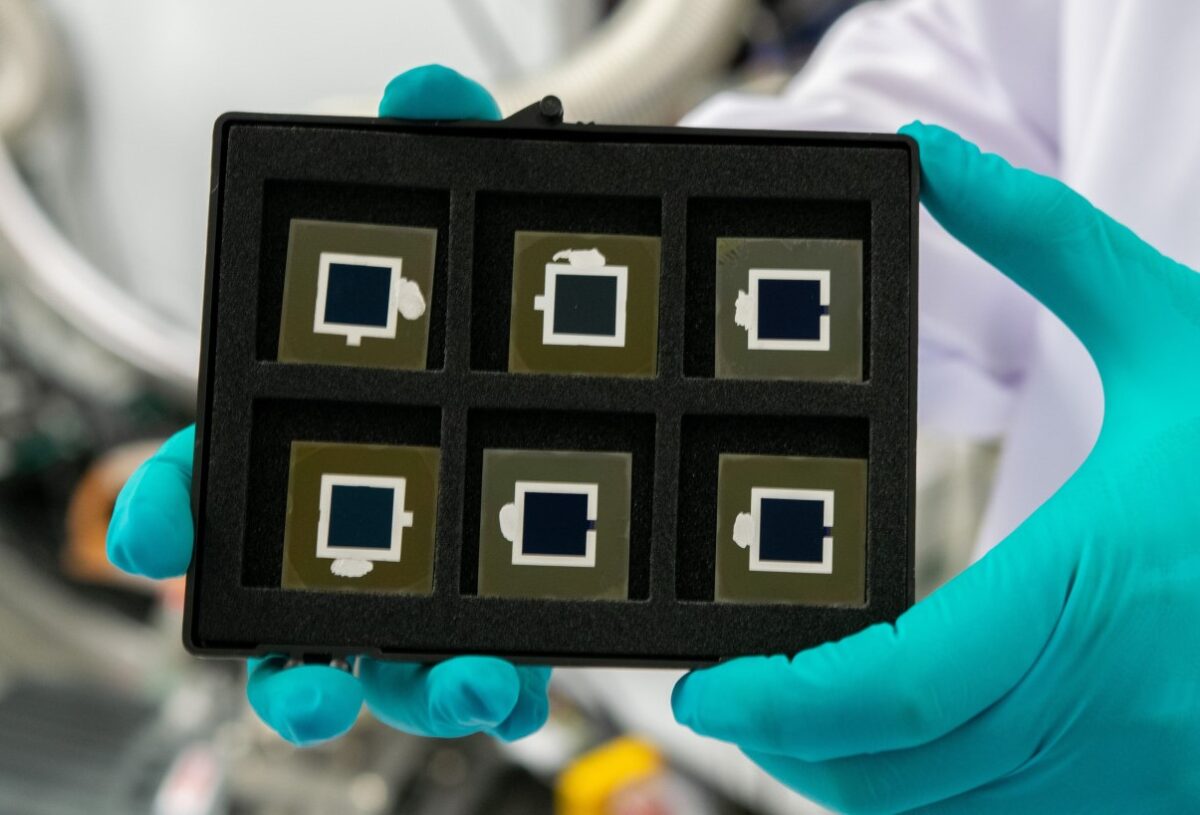From pv magazine Global
A research group at the National University of Singapore (NUS) has fabricated a triple-junction perovskite-perovskite-silicon solar cell that integrates cyanate (OCN) ions in an ultrawide-bandgap (UWBG) perovskite absorber.
“The incorporation of OCN ions significantly reduces the nonradiative recombination in the ultrawide bandgap perovskite film,” the research’s lead author, Yi Hou, told pv magazine. “Therefore, the single-junction perovskite solar cells incorporated with cyanate can achieve a higher open-circuit voltage of 1.422 V compared to 1.357 V for conventional perovskite solar cells.”
The scientists explained that OCN may be a suitable replacement for bromide as a precursor material in the perovskite lattice structure. “Our research confirms the atomic-scale incorporation of OCN anions into the perovskite lattice,” Hou said. “The low-damage, atomic-resolution Transmission Electron Microscopy (TEM) confirms the incorporation effect at atomic resolution for the first time. This is also the first time atomic-resolution TEM images have been captured for a hybrid ultrawide bandgap perovskite film.”
The academics fabricated the triple-junction cell with a bottom silicon device with a heterojunction (HTJ) architecture, a middle perovskite solar cell, and a top perovskite cell integrating the UWBG perovskite absorber with a 5% OCN content.
The triple junction device had a structure integrating the HJT cell, a substrate made of glass and indium tin oxide (ITO), a hole transport layer (HTL) based on a phosphonic acid called methyl-substituted carbazole (Me-4PACz), a perovskite absorber with an energy bandgap of 1.55 eV, a buckminsterfullerene (C60) electron transport layer (ETL), a tin(IV) oxide (SnO2) layer, another ITO layer, an HTL made of nickel(II) oxide (NiOx) and Me-4PACz, the UWBG perovskite absorber, a buckminsterfullerene (C60) electron transport layer (ETL), a SnO2 layer, an ITO layer, and a lithium fluoride (LiF) as an inorganic ionic dopant.
“The UWBG perovskite uniformly covers the middle cell without obvious damage to the underneath layer,” the researchers explained. “The smooth top surface and robust performance of the dual-junction half-cell create an ideal substrate for the subsequent deposition of UWBG perovskites.”
Tested under standard illumination conditions, the triple-junction cell achieved a maximum efficiency of 27.62%, an open-circuit voltage of 3.132 V, a short-circuit current density of 11.58 mA/cm2, and a fill factor of 76.15%. For comparison, a benchmark device without the incorporation of OCN ions achieved an efficiency of 25.32%, an open-circuit voltage of 3.021 V, a short-circuit current density of 11.48 mA/cm2, and a fill factor of 73.01%.
According to the research team, the introduction of OCN elevates the open-circuit voltage from 1.357 V to 1.422 V and results in the highest combination of open-circuit voltage and fill factor for UWBG perovskite solar cells. The cell was also able to retain around 80% of its original efficiency after 300 h.
“This accomplishment significantly surpasses the power conversion efficiencies previously reported for all other perovskite-based triple-junction tandems as well as single-junction perovskite and silicon solar cells,” Hou stated.
The cell was introduced in the study “Triple-junction solar cells with cyanate in ultrawide bandgap perovskites,” published in nature.
This content is protected by copyright and may not be reused. If you want to cooperate with us and would like to reuse some of our content, please contact: editors@pv-magazine.com.









By submitting this form you agree to pv magazine using your data for the purposes of publishing your comment.
Your personal data will only be disclosed or otherwise transmitted to third parties for the purposes of spam filtering or if this is necessary for technical maintenance of the website. Any other transfer to third parties will not take place unless this is justified on the basis of applicable data protection regulations or if pv magazine is legally obliged to do so.
You may revoke this consent at any time with effect for the future, in which case your personal data will be deleted immediately. Otherwise, your data will be deleted if pv magazine has processed your request or the purpose of data storage is fulfilled.
Further information on data privacy can be found in our Data Protection Policy.